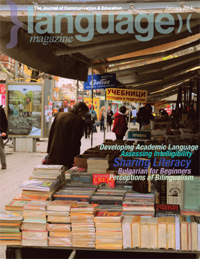 The survival of Aramaic, once the Middle East’s lingua franca, is in jeopardy amid regional turmoil.
The survival of Aramaic, once the Middle East’s lingua franca, is in jeopardy amid regional turmoil.
Recently, the Syrian government sent troops to the ancient, predominantly Christian village of Maaloula, where rebels have battled against the regime. Maaloula, a scenic village of about 3,300 perched high in the mountains, is one of the few places in the world where residents still speak a version of Aramaic, the language of biblical times believed to have been used by Jesus.
Prior to the incursion, the United Nations Educational, Scientific and Cultural Organization (UNESCO) had already listed it as an endangered language in Iraq, Iran, and Syria.
“Aramaic boasts an exceptionally long, continuously documented history of over 3,000 years, longer than all other known Semitic languages to which, for example, Arabic and Hebrew also belong,” Paul M. Noorlander, a researcher from Leiden University’s Centre for Linguistics, told Al Arabiya News.
Western neo-Aramaic “is now confined to a couple of diminishing thousands of mainly Christian but also a few Muslim speakers from a few villages in Syria, among them well-known Maaloula, belonging to the UNESCO World Heritage,” he said.
Maaloula is a village located 56 km northeast of Damascus. About 2,000 of its people, according to a 2005 census, speak Western Aramaic, the language of Jesus Christ. It is one of only three villages where Western Aramaic is spoken in Syria. Noorlander estimates that there were about 150 Eastern Aramaic dialects spoken by Jews and Christians in Iraq, Iran, and Turkey. However, many of these dialects have disappeared as Jews moved to Israel and Christians to the West.
In November, the World Council of Arameans urged Turkish Prime Minister Recep Tayyip Erdogan to recognize and support the country’s “indigenous” endangered Aramean people.
The NGO called for the constitutional recognition of Arameans as a minority. While there are Assyrian schools in the northern semi-autonomous region of Kurdistan in Iraq, the Kurdish authorities have been criticized for “trying to make life difficult for those schools and force them to teach false Kurdish history in order to Kurdify the next generations.”
After the fall of the Ottoman Empire, the emergence of nation states such as Iraq, Iran and Syria heralded the beginning of Kurdish struggles for independence.
Noorlander explained that: “Aramaic speakers found themselves largely in the cross-fire between Kurds and central governments.”
The researcher described religion as key in keeping the language alive, but also “the attitude of the speakers themselves, wherever they may find themselves, is fundamental.







California Invites Public Comment on English Framework
Californians are being invited to comment on their state’s first framework based on the Common Core State Standards for English language arts.
The English Language Arts/English Language Development Framework for California Public Schools: Kindergarten Through Grade Twelve (ELA/ELD Framework) will provide guidance for implementing the new Common Core State Standards and California’s new English Language Development Standards. According to the California Department of Education (CDE),” the ELA/ELD Framework will help ensure that California’s students graduate with the knowledge and skills they need to succeed in college and careers. The ELA/ELD Framework will help teachers, publishers, and other educators design instructional materials, curriculum, instruction, assessment, and professional learning.”
The California State Board of Education adopted the Common Core State Standards for English language arts in 2010, and new English Language Development Standards in 2012. This new ELA/ELD Framework is aligned to those standards. The Board last approved a framework in this area in 2006.
The CDE claims that “the ELA/ELD Framework breaks new ground by providing a blueprint for relating English language development for English learners to the English language arts standards for a cohesive program. The draft framework focuses on the teaching and learning of English literacy and language in the English classroom and includes strategies for extending that focus into all subject areas. It also provides direction to educators to implement the standards in the context of California’s diversity and helps them teach the critical thinking skills students will need for 21st century jobs. The ELA/ELD Framework has two primary audiences: educators and developers/publishers of curriculum programs and materials.”
The public has until February 13, 2014, to review the Framework, available on the CDE’s Public Review and Comment on the ELA/ELD Framework Web page , where comments can be left via the digital survey or by email. Hard copies of the draft framework may also be reviewed at the 23 Learning Resource Display Centers statewide.